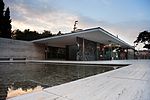Barcelona Metro line 8
Barcelona Metro linesLlobregat–Anoia LineMetre gauge railways in SpainTransport in Cornellà de LlobregatTransport in L'Hospitalet de Llobregat ... and 2 more
Transport in Sant Boi de LlobregatTransport in Sants-Montjuïc
— Line 8, coloured pink (termini: Plaça Espanya – Molí Nou-Ciutat Cooperativa) and operated by FGC, is part of the Barcelona Metro network, and therefore of the larger ATM fare-integrated transport system. It joins Plaça Espanya, in the Sants-Montjuïc district of Barcelona with metropolitan area municipalities of L'Hospitalet de Llobregat, Cornellà de Llobregat and Sant Boi de Llobregat.
Excerpt from the Wikipedia article Barcelona Metro line 8 (License: CC BY-SA 3.0, Authors).Barcelona Metro line 8
Gran Via de les Corts Catalanes, Barcelona
Geographical coordinates (GPS) Address Nearby Places Show on map
Geographical coordinates (GPS)
| Latitude | Longitude |
|---|---|
| N 41.375 ° | E 2.14916 ° |
Address
Font de la Plaça d'Espanya
Gran Via de les Corts Catalanes
08001 Barcelona
Catalonia, Spain
Open on Google Maps











